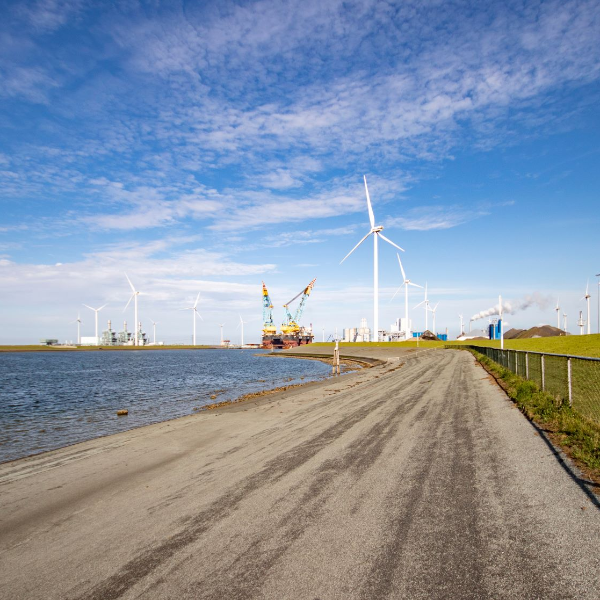PAWOZ Eemshaven environmental impact study – important advice in the energy transition

PAWOZ Eemshaven environmental impact study – important advice in the energy transition
The PAWOZ programme is investigating possible routes for connections between wind farms in the North Sea and Eemshaven. The green energy generated by wind farms is essential to meeting Climate Agreement targets, but between its source at sea and on-land destination lies the Wadden Sea – a Natura 2000 area with UNESCO World Heritage status. On land, too, potential routes cross highly valued agricultural land. Witteveen+Bos is working together with Royal HaskoningDHV on a planMER and integrated impact analysis assessing the pros and cons of the various possible routes.
PAWOZ is initially focusing on the routes available for distributing energy from two wind farms above the Wadden Islands: Doordewind (DDW), which has a 4 GW capacity, and Ten Noorden van de Waddeneilanden (TNW), a demonstration project with 500 MW for hydrogen. If required, TNW can also supply electricity.
Eemshaven
In time, however, more wind farms will be built in the North Sea. For this reason, routes which provide future opportunities for power lines and/or hydrogen pipelines from new wind farms are also being considered. The routes will run from (future) wind farms in the North Sea, through the Wadden Sea, along the Wadden Sea coast, across the mainland to the national high-voltage grid at Eemshaven, and then on to the Netherlands’ hydrogen network.
Eemshaven was selected on the basis of previous studies as the preferred location for energy to come ashore via cables and/or pipelines. This is because a high-voltage grid and a hydrogen network are already available in and around the area which connect to the national grid and the Netherlands’ hydrogen network. The decision also took into account the fact that the industry in this part of Groningen has a huge need for renewable energy, meaning substantial carbon reductions can be immediately achieved.
PAWOZ is examining routes with sufficient physical and environmental space to lay cables and pipelines. Sufficient physical space means that the routes are technically feasible based on the technical requirements and constraints of cables and pipelines. Sufficient environmental space means that permits for the routes can be granted based on impact studies.
PlanMER
The Environment and Planning Act requires a ‘planMER’ for a project of this size. A planMER is an environmental impact report that systematically, transparently and objectively portrays the environmental consequences of the project. It also describes measures to prevent or mitigate negative impacts on the environment. The scope of a planMER, however, is wider than just environmental aspects. In the ‘Integrale Effect Analyse’ to be prepared by Witteveen+Bos and Royal HaskoningDHV, routes will also be assessed against other factors.
When installing cables and pipelines in the Wadden Sea, one of the biggest challenges is to cross the region as responsibly as possible. The Wadden Sea is a unique and protected nature reserve also used for recreation, fishing and shipping. Important considerations include landscape, cultural-historical and archaeological value for the northern Netherlands and the agricultural lots important for seed potato cultivation.
Energy transition tunnels
One alternative on this programme is an energy transition tunnel. Because the cables and pipelines have to pass through a sensitive Natura 2000 area, an alternative has been developed in which they are inserted into bored tunnels beneath the seabed. These tunnels would be approximately 27 kilometres long, have an entry point on an artificial island in the North Sea, and pass beneath the Wadden Sea before exiting near Eemshaven. It represents an innovative idea that has not been applied in this form anywhere in the world.
To determine whether an energy transition tunnel is practicable, we are examining a number of key aspects:
- heat generation and cooling concepts for this;
- the consequences of possible short circuits, electromagnetic interference, and earthing;
- installation – how to install large lengths of cable or pipeline safely and efficiently in a tunnel;
- drilling a 27-kilometre tunnel to an artificial island with no intermediate point;
- low-maintenance design for overall safety and safe maintenance.
The Ministry of Economic Affairs and Climate Policy (EZK) awarded the project to draft a planMER to Witteveen+Bos and Royal HaskoningDHV due to our broad knowledge in the relevant specialisations. This includes knowledge of the Wadden Sea’s ecological system, the technical issues surrounding cables and pipelines, and the stakeholders involved, as well as affinity with (and a network in) the northern part of Groningen and the Wadden Islands. On this project, we are working intensively with TenneT, Gasunie, the Province of Groningen, and the EZK Ministry.
A high-quality basis was laid by assembling a team with subject specialists from different disciplines, including (marine) ecology, electrical engineering, hydrogen, law, and engagement and stakeholder management. By pooling this knowledge and expertise to study the various possible transport routes, we will be able to arrive at a recommendation for the minister. The studies will lay the groundwork for a programme in which the energy and climate minister will decide which routes can be used for cables and pipelines. Completion of the planMER is scheduled for the end of 2024.